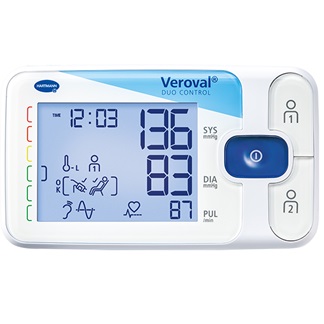فيروفال® ديو كنترول جهاز قياس ضغط الدم عند العضد

يقدم جهاز فيروفال® ديو كنترول لقياس ضغط الدم قياسات صحيحة، حتى في حالات اضطراب نظم القلب، بفضل تقنية الاستشعار المزدوج Duo Sensor الفريدة.
اعرف المزيد
لتحديد ضغط دمك، يجب قياس قيمتين:
يتم عرض القيمتين المقاستين لضغط الدم بوحدة مم زئبق.
لتقييم النتائج بشكل أفضل، تقدم أجهزة قياس ضغط الدم من فيروفال® نظام ألوان الإشارات الضوئية الذي يصف النتائج مباشرة من أجل السماح بتصنيف أسهل للقيمة المقاسة. ولقد طوّرت منظمة الصحة العالمية (WHO)، والجمعية الأوروبية لطب القلب (ESC)، والجمعية الأوروبية لارتفاع ضغط الدم (ESH) الملخص التالي لتصنيف قيم ضغط الدم:
| مؤشر النتائج |
التقييم | الضغط الانقباضي | الضغط الانبساطي | |
| أحمر | ارتفاع ضغط الدم من المستوى الثالث | فوق ١٧٩ مم زئبق | و/أو | فوق ١٠٩ مم زئبق |
| برتقالي | ارتفاع ضغط الدم من المستوى الثاني | ١٦٠-١٧٩ مم زئبق | و/أو | ١٠٠ - ١٠٩ مم زئبق |
| أصفر | ارتفاع ضغط الدم من المستوى الأول | ١٤٠-١٥٩ مم زئبق | و/أو | ٩٠-٩٩ مم زئبق |
| أخضر | طبيعي مرتفع | ١٣٠-١٣٩ مم زئبق | و/أو | ٨٥ - ٨٩ مم زئبق |
| أخضر | طبيعي | ١٢٠-١٢٩ مم زئبق | و/أو | ٨٠ - ٨٤ مم زئبق |
| أخضر | مثالي | لغاية ١١٩ مم زئبق | و | لغاية ٧٩ مم زئبق |